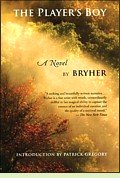|
The Player's Boyby BryherReviewed by Margaret Donsbach
Sands does not entirely descend into purgatory. In the spring of 1608, while his company is working in the countryside, he stumbles across a playwright, a teacher more skilled and patient even than his beloved Master Awsten. For once, he is given a role in which he yearns to shine, though it is the most difficult of his life. Trying to work out how to help him, Mr. Beaumont comments, "the part should speak itself, and thou art strangling it." Sands replies, "It is because it is so beautiful..." By 1618, disillusion has set in. "Rubbish heaps soiled the meadows where we used to set out maypoles, and now that the ditches were no longer cleaned, some of the ground was turning back into marsh." Emblematic of the decline is the impending execution of Sir Walter Raleigh, who has offended Spain - King James wishes, at all costs, to mollify England's old enemy. Bryher wrote The Player's Boy in the years following World War II, and it reflects her feelings about England's pre-war appeasement of Hitler. It's a gloomy, but achingly beautiful novel. (1953; new Paris Press edition 2006, 208 pages) More about The Player's Boy from Powell's Books or Amazon.com
The Fourteenth of October (1952), about a Saxon boy in his teens who witnesses the Battle of Hastings. See Review or More info at Amazon.com Roman Wall (1954), set during the Roman period in what is now Switzerland. More info Ruan (1960), about a boy in sixth century Cornwall who runs away to become a sailor. See Review or More info at Amazon.com
The Days of Mars: A Memoir, 1940-1946 (1971). More info
Shakespeare Without Women: Representing Gender and Race on the Renaissance Stage by Dympna Callaghan (2000). More info The Routledge Anthology of Renaissance Drama by Simon Barker and Hilary Hinds (2003). More info The English Renaissance Stage: Geometry, Poetics and the Practical Spatial Arts, 1580-1630 by Henry S. Turner (2006). More info

Shakespeare in Love
Wikipedia entry on Sir Walter Raleigh
Back to Novels of the Renaissance
|
